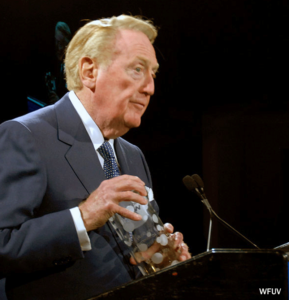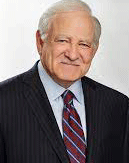By SCOTT FYBUSH
 It’s time once again for our Year in Review, the 29th time we’ve gathered up our headlines from the previous 12 months and tried to sum it all up for you.
It’s time once again for our Year in Review, the 29th time we’ve gathered up our headlines from the previous 12 months and tried to sum it all up for you.
Today, we’re doing the “Top Ten Stories of the Year” portion of our Year in Review, and we’ll wrap up the whole package on tomorrow with “Those We Lost.” We’ll resume our regular NorthEast Radio Watch report with an update on Tuesday, January 3. In the meantime, our own Twitter and Facebook feeds and RadioInsight will be here with any breaking news!
In this installment, we spotlight what were, in our opinion, the biggest stories of the year across the region we cover. Think we left something out? Weigh in below in the comments…
10. Vin
You could, we suppose, argue about who was the most consequential voice in the history of baseball on the radio, but if your final answer is anything other than “Vin Scully,” you’d be wrong and that’s that.
 His career in his native New York was relatively short – less than a decade after graduating from Fordham University (where he helped start WFUV), he’d become the broadcast voice of the Brooklyn Dodgers and then followed the team west to Los Angeles – but the sound of New York never left his voice and the stories of Brooklyn never left his majestic storehouse of sports memories, becoming part of a tapestry of history that felt like it could just keep going out over the airwaves summer after summer.
His career in his native New York was relatively short – less than a decade after graduating from Fordham University (where he helped start WFUV), he’d become the broadcast voice of the Brooklyn Dodgers and then followed the team west to Los Angeles – but the sound of New York never left his voice and the stories of Brooklyn never left his majestic storehouse of sports memories, becoming part of a tapestry of history that felt like it could just keep going out over the airwaves summer after summer.
It couldn’t last forever, of course, and while we didn’t hear or see much from Scully after his 2016 retirement from 67 seasons of Dodger baseball, it was still a sad day indeed when he left us for good in August.
9. Sports Radio Seeks New Footing
It wouldn’t be a year of NERW without some variation of the perennial “WEEI in Turmoil” story, but it wasn’t just Audacy’s Boston station that left 2022 with a lineup that looked very different from the one it had at the start of the year. While the sports-talk format continued to be a lucrative one, it felt pressure in a year when two of its biggest owners faced financial pressures.
In Boston, where Beasley’s WBZ-FM (98.5 the Sports Hub) landed among the top-10 revenue generators in the nation, Beasley’s overall corporate cutbacks still cost the jobs of several staffers, with morning hosts Toucher and Rich having to step in to hire back their own producer in a moment that didn’t look good for the company. The Sports Hub cutbacks were good news for WEEI, which was able to add to its roster and end the year back in contention against WBZ-FM.
In New York, Good Karma took over operation of ESPN Radio’s WEPN-FM (98.7) and unveiled another revised lineup of hosts aimed at creating a more local feel to better take on Audacy’s dominant WFAN. In Philadelphia, the Beasley cuts further reduced WPEN (97.5)’s ability to take on Audacy’s WIP, but changes loom at WIP, too, especially the impending exit of morning veteran Angelo Cataldi early in 2023.
8. A Big Centennial Year
 While radio began celebrating its 100th birthday in 2020 (yes, KDKA was there early on; no, it wasn’t really the “first” anything), it was 2022 that marked the centennial of radio’s first big boom year. And while the pandemic meant that KDKA and other pioneers such as WBZ never got any big public celebration, by 2022 some stations were ready to mark their big anniversaries in a more public way.
While radio began celebrating its 100th birthday in 2020 (yes, KDKA was there early on; no, it wasn’t really the “first” anything), it was 2022 that marked the centennial of radio’s first big boom year. And while the pandemic meant that KDKA and other pioneers such as WBZ never got any big public celebration, by 2022 some stations were ready to mark their big anniversaries in a more public way.
That’s how we ended up in a ballroom in Albany early in the year enjoying a live drama and music presentation on the history of WGY, and how we spent much of the year listening to the 103 (!) episodes of the WHAM centennial podcast that’s been a long-term labor of love from the station’s Joe Lomonaco. Other members of Club 1922 celebrated, too, including New York’s WOR, Hartford’s WDRC and even Syracuse’s WSYR, which has only a tenuous claim to that birth year.
7. Flow Flows Up the Toronto Dial
After many years without any commercial radio station targeting Toronto’s growing Black and Caribbean communities, the city had finally settled in with two competing operators, but both were somewhat unstable as 2022 dawned. After the death of founder Fitzroy Gordon, CKFG (G98.7) ended up in bankruptcy, sold to a new owner, Neeti P. Ray, whose specialty was in Asian-language broadcasts. Toronto’s original Black-focused station, CFXJ (Flow 93.5), had gone through multiple format adjustments and several owners, ending up as a format outlier with corporate parent Stingray.
 Ray and Stingray found a solution in February: Stingray sold the “Flow” branding to Ray, who relaunched CKFG as “Flow 98.7,” replacing most of Gordon’s former staff with existing Flow air talent while trying to make the most of the limited 98.7 signal and the constraints of a license meant to specifically serve the Afro-Caribbean population of Toronto.
Ray and Stingray found a solution in February: Stingray sold the “Flow” branding to Ray, who relaunched CKFG as “Flow 98.7,” replacing most of Gordon’s former staff with existing Flow air talent while trying to make the most of the limited 98.7 signal and the constraints of a license meant to specifically serve the Afro-Caribbean population of Toronto.
On Stingray’s end, the company hoped to find Toronto success with a personality-heavy talk/hot AC format that had worked well for it in several midwestern markets. At year’s end, though, “Today’s 93.5” wasn’t catching fire in the ratings, especially in comparison with its top-rated classic hits sister “Boom 97.3.” Also hampered by a restricted signal, 93.5 has applied to add on-channel boosters in hopes of reaching parts of the core Toronto market that have trouble hearing the signal.
6. Rumba, Block Find Their Niches
For big operators such as iHeart and Audacy, big-market cluster operation has long been a game of mass appeal: find the formats that can garner the largest audiences in the most inoffensive way and milk them for everything they’re worth. What happens when there’s no obvious hole for a new mass-appeal format, though?
 In some ways, 2022 was a year for more niche formats to find their places in some of those clusters. After spinning the wheel on various flavors of AC (rhythmic, hot, soft, rhythmic), iHeart’s WISX (106.1) in Philadelphia dropped “Real 106.1” in March to go Spanish hits as “Rumba 106.1,” WUMR.
In some ways, 2022 was a year for more niche formats to find their places in some of those clusters. After spinning the wheel on various flavors of AC (rhythmic, hot, soft, rhythmic), iHeart’s WISX (106.1) in Philadelphia dropped “Real 106.1” in March to go Spanish hits as “Rumba 106.1,” WUMR.
While the Rumba brand wasn’t new to the market – iHeart had plugged it in a few years earlier on what’s now modern rock WRFF (104.5, then WUBA) – its appearance this time came as part of a more coherent niche strategy from iHeart, which is using Philly’s Rumba as part of a regional sales platform that includes Spanish-language signals in nearby Reading as well as Boston’s WZRM (Rumba 97.7), which has established a small but lucrative foothold in that market.
Audacy pursued a similar strategy with urban-focused formats in several of its markets: in New York, the launch of classic hip-hop WXBK (94.7 the Block) late in 2021 added personalities in 2022, most of them familiar voices from competing stations such as WBLS. While the Block won’t ever be the number one (or even a top-10) station in New York, it adds a new demographic to Audacy’s sales portfolio at relatively low cost. That’s also why Audacy ended up adding the venerable “WAMO” brand to its Pittsburgh cluster, picking up the hip-hop format and 107.3 translator from Tim Martz’ Radio Power to flank its other music offerings in town.
5. Seven Mountains’ Family Affair
By now, “Seven Mountains expanding” has an almost regular spot in this annual list, as the mother-and-daughter company based in Kentucky continues to grow its footprint across the southern reaches of NERW-land, not just in Pennsylvania but in adjoining pieces of New York and beyond.
 In 2022, Kristin Cantrell’s company made a few strategic acquisitions in new corners of the Keystone State, adding to its holdings in the Poconos, Bloomsburg, and Clarion, but those were peanuts compared to Seven Mountains’ big deal, acquiring Forever’s stations in State College, Johnstown, Altoona, Meadville/Oil City/Franklin, New Castle and Lebanon.
In 2022, Kristin Cantrell’s company made a few strategic acquisitions in new corners of the Keystone State, adding to its holdings in the Poconos, Bloomsburg, and Clarion, but those were peanuts compared to Seven Mountains’ big deal, acquiring Forever’s stations in State College, Johnstown, Altoona, Meadville/Oil City/Franklin, New Castle and Lebanon.
The $17 million deal was very much a family affair: Cantrell, of course, is the daughter of Forever principal Kerby Confer, who’s retaining his stations around Pittsburgh and York.
The story of what becomes of those former Forever stations will be one for 2023, especially in State College, where the new year is about to bring an almost complete reshuffling of the commercial dial as Seven Mountains moves formats and callsigns around to the new stations it’s acquiring from Forever while spinning off most of the signals it had already owned across town. (We’ll have all the details on that in our first 2023 issue on January 3.)
4. The City of Jim Gardner-ly Love
A city that venerates a strange orange blob as its most famous sports mascot, goes crazy over a steak sandwich (pardon, “hoagie”) and boos Santa Claus might not seem to be the most hospitable place for a gentlemanly white-haired news anchor from a bygone era – but Philadelphia’s affection for Jim Gardner and his flagship 6:00 newscast on ABC’s WPVI (Channel 6) was very real and very visible as he spent the year moving closer to his retirement.
 Once Gardner announced his farewell date in December after 45 years on the air, the city went over the top in good Philly fashion. Residents put on fake white Gardner mustaches to salute him at the Thanksgiving parade, filled social media with Gardner selfies as he made his way around town – and on the night of his final newscast, they tailgated. A newscast. From the Target parking lot across Monument Road.
Once Gardner announced his farewell date in December after 45 years on the air, the city went over the top in good Philly fashion. Residents put on fake white Gardner mustaches to salute him at the Thanksgiving parade, filled social media with Gardner selfies as he made his way around town – and on the night of his final newscast, they tailgated. A newscast. From the Target parking lot across Monument Road.
Gardner, of course, stepped outside to take selfies with them, as you do when you’re the only thing in town bigger than Gritty.
While Gardner talked up his successor, the reality of corporate TV in the 21st century is that no new anchor is likely to stick around longer enough to build that kind of love from viewers in a splintered age of viewing.
Of course it wasn’t just Gardner leaving a long-established anchor seat: Pat Callaghan of Maine’s WCSH/WLBZ, Tom Griffith of New Hampshire’s WMUR and Doug Emblidge and Ginny Ryan of WHAM-TV here in Rochester were among other significant retirements, all of them into or beyond their fourth decade at the desk.
North of the border, the most prominent anchor desk departure wasn’t voluntary at all: 11 years into what looked like an extremely successful tenure at the helm of CTV’s national newscast, Lisa LaFlamme disappeared from the screen in June, then reappeared in a video message from her cottage that made it very clear her sudden “retirement” was anything but. While LaFlamme didn’t get her job back, her ouster upended CTV management. Internal investigations and a flood of outside media reports exposed a toxic workplace culture of sexism, ageism and harassment that cost several top CTV/Bell executives their jobs.
3. Canada Revamps Ownership Rules
Here’s a story that we can already almost guarantee will also appear in our top 10 list at the end of 2023, if only because it broke so late in 2022: after decades of regulations that fostered the consolidation of Canadian commercial broadcasting into just a tiny handful of big players nationwide, the CRTC is now paving the way toward another kind of consolidation by allowing owners to control a larger number of FM signals in each individual market.
While the FCC long ago allowed US broadcasters to own up to five FMs in each large market, the CRTC held fast to a policy that limited owners to just two FMs and two AMs each. Now that rule will shift to four stations total, three of which can be FM. That’s likely to put some pressure on smaller owners such as Zoomer Media and Evanov to look at lucrative offers for their FM signals in big markets, or lead some of the big companies to arrange strategic swaps to create more profitable fiefdoms in each of their best markets.
It’s also another piece of the ongoing erasure of the AM band north of the border: in larger markets, if the only thing holding a company back from a third FM station is the presence of a second AM, that AM signal sure does begin to look expendable, doesn’t it? And in smaller markets where an owner was hanging on to an AM signal only because it already had two FMs, it’s easy to imagine a rush of AM-to-FM conversion requests hitting the CRTC agenda pretty quickly.
Will the CRTC ever follow the lead of most other nations and raise the local ownership caps further? One step at a time – but this one is clearly moving the needle in that direction.
2. Matty (And Others!) Out of Mornings
One of the toughest challenges for an established personality is knowing when it’s time to retire. It’s a tough call – you don’t want to leave a good gig too early, especially when there aren’t many other good options out there for a jock of a certain age. At the same time, you don’t want to tarnish your legacy by sticking around after you’ve lost your game.
 In Boston, the legendary Matt Siegel seemed like a permanent fixture on top-40 WXKS-FM (Kiss 108), still spinning the hits into his seventies. But things took a turn in 2021, when he showed an on-air nasty streak that led to a split with one of his “Matty in the Morning” co-hosts.
In Boston, the legendary Matt Siegel seemed like a permanent fixture on top-40 WXKS-FM (Kiss 108), still spinning the hits into his seventies. But things took a turn in 2021, when he showed an on-air nasty streak that led to a split with one of his “Matty in the Morning” co-hosts.
While iHeart stuck with Siegel after that incident, something went bad again very suddenly at the end of April. Siegel vanished from the show without explanation for two weeks, then returned with an uncomfortable-sounding recorded farewell announcement.
Siegel said his family had noticed him sounding “cranky” on the air, something he’s never wanted to be – and as a result, he said, “it’s time” for him to retire, effective immediately, leaving co-host Billy Costa at the helm of a revamped morning show.
It’s not the way any veteran air talent wants to go out, which makes the “retirement” of New York’s legendary Scott Shannon all the more dramatic by contrast. When the veteran of Z100 and WPLJ came to the end of his latest contract at his current morning home, Audacy’s WCBS-FM (101.1), he and co-host Patty Steele exited on their own terms, going out with a proper celebration while making it clear that both are still hoping for a next chapter in their long careers.
North of the border, another cautionary tale comes from Corus’ Q107 (CILQ) in Toronto, where longtime morning man John Derringer became the subject of numerous complaints from current and former co-workers who alleged a pattern of abusive and sexist behavior, especially towards several of his co-hosts at the classic rock station. Derringer was suspended, then let go after an outside investigation – but with no plan B in place, Q107 ended the year still without a replacement morning show.
1. WINS Moves to FM
One of our favorite parlor games for years now has been trying to figure out when two lines would cross: on one side, the continuing erosion in AM listening nationwide, and on the other, the risk that New York’s CBS Radio/Entercom/now Audacy cluster would face by moving just one of its two cash-cow all-news stations to FM while leaving the other as an AM-only signal.
 It was one of those questions with no perfect answer, but few (including us) foresaw what Audacy’s deciding factor would actually be: the outcome of union negotiations allowing the struggling company to combine what had been two proudly separate newsroom staffs at WCBS (880) and WINS (1010).
It was one of those questions with no perfect answer, but few (including us) foresaw what Audacy’s deciding factor would actually be: the outcome of union negotiations allowing the struggling company to combine what had been two proudly separate newsroom staffs at WCBS (880) and WINS (1010).
The other big risk factor that had kept the company from moving one of the two stations to FM was the fear of losing revenue from an FM music station, but as 2022 played out, it was becoming clear that one Audacy FM wasn’t producing that much revenue anyway. Lagging in both ratings and revenue, WNYL (92.3)’s “Alt” modern rock format became expendable – and by the time “WINS Day” came around on 10/10, Audacy was ready to pull the trigger: at month’s end, it sent “Alt” to an HD2 feed and brought WINS to the FM dial, with the somewhat ungainly “1010 WINS All News 92.3 FM” moniker.
We’ll see more of Audacy’s strategy play out in 2023, as it works to establish WINS on AM and FM as its flagship 24-hour all-news outlet while finding a new path for WCBS that seems likely to include more talk programming alongside its existing interruptions to all-news, including Mets baseball and Rutgers sports.
We’ll be watching, too, to see whether moving WINS’ audience from AM to FM has any effect on the rest of the AM dial, especially on spoken-word competitors WOR (iHeart) and WABC (Red Apple) with no easy path to an FM simulcast.
It’s all part of an even bigger story, of course, as the century-old AM radio medium continues to head into its sunset years. Which AM signals won’t survive past 2023? We’ll be keeping track.
> > > Coming later Friday, Dec. 30: Those We Lost















